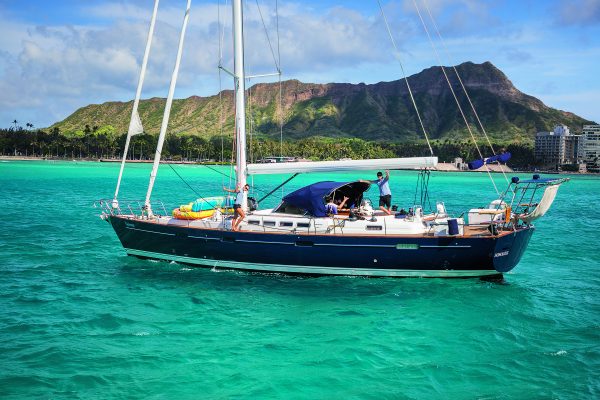Jimmy Cornell gives his expert analysis of the essential features that any offshore cruising yacht should have
Sails, deck gear and rigging
For a long voyage one should make sure that the mainsail is made as strong as possible, with double, ideally triple UV-resistant zigzag-stitching and protection patches in the areas where the sail may touch the spreaders when fully let out. The furling foresail(s) should be provided with anti-UV strips.
I have considered the subject of the type of mainsail on a cruising boat and have no doubt that a fully battened mainsail, with slab reefing, is still the best answer for those who are interested in performance. Mainsail furling systems have evolved, and some of the boom furling arrangements combine the best of two worlds, by offering a quick and easy way to reduce sail surface, and, as the furling mainsail is provided with battens, the loss of performance is quite minimal.
Spinnakers and headsails
Spinnakers should be provided with adequate dousers or it will be difficult to drop them in a squall when this needs to be done quickly. While there isn’t much to choose between well-cut spinnakers, some dousers are better than others. Ideally, as on the Parasailor, the collar should be rigid and not made of soft material. The douser collar should also have a wide enough mouth to snuff the spinnaker easily.
Various light weather sails, such as asymmetric spinnakers, code zeros, cruising chutes, gennakers etc, come with their own furling gear, and can be a useful addition to the sailing wardrobe, as they are relatively easy to set up and take down on a short-handed boat.

Rigging
Initially I was determined to have a cutter rig on Aventura IV, but was eventually persuaded that a fractional rig with swept-back spreaders would be more efficient than a standard cutter rig. Indeed, the Solent jib performed very well when close-hauled and the mast was also much better stayed than on the previous Aventura. But I still insisted on a split rig, with a staysail set on an inner forestay to be used in stronger winds. It was a good solution and reinforced my conviction that the flexibility provided by a two-foresail configuration is a major advantage on any boat over 40ft.
While setting up the running rigging it is a good idea to have a close look at the existing deck layout and the run of the various sheets and lines, which should have a clear unobstructed run back to the cockpit helped by turning blocks at critical points.
As to halyards, the mast should have enough dedicated channels for spinnaker and foresail halyards, and their backups. On Aventura IV, the mainsail halyard was of Dyneema non-stretch material and I decided to have the boom topping lift from the same material so as to have a permanent backup for the mainsail halyard. I always prefer to have two spinnaker halyards so they can be used on the lee side when the sail is hoisted. The same halyards were used for the code 0 sail.
Deck layout
An efficient and functional deck layout is an essential safety feature that allows me and my crew to do most of the sail handling jobs from the cockpit. It is essential that the lines coming to the cockpit are colour coded and brought to individual clutches. The same goes for the control lines from the furling gear. Some production boats fail badly in this respect.
For tradewind conditions, use a fixed pole when running or broad reaching. It is a simple and efficient system that I have used on all my boats, and one I highly recommend.
For efficient sail handling, especially when short-handed, electric winches are almost indispensible. For example, when a foresail needs to be furled quickly before a squall arrives, the furling line can be wound on the electric winch at the touch of a button, while the other hand can ease the sheet gradually as the sail is being furled. This effortless operation rarely takes more than one minute. It works equally well when reefing the mainsail from the cockpit, with the reefing line being hauled in by the electric winch while the halyard is paid out manually.




